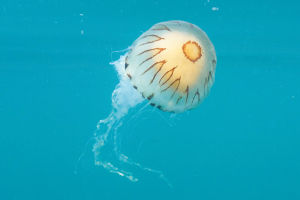In the azure sea, a beautiful and transparent creature drifts gracefully, resembling floating mushrooms that shimmer with a ghostly light as they swim elegantly and beautifully.
This is the jellyfish, a lower form of animal with a soft body, devoid of bones, primarily composed of water.
Although jellyfish appear gentle and harmless, they are, in fact, ferocious carnivores. Beneath their umbrella-like bodies are long, thin tentacles that serve as both digestive organs and weapons. These tentacles are covered with countless venomous stinging cells, capable of injecting toxins. Once prey is stung, it quickly becomes paralyzed and dies.
The mechanism of jellyfish bioluminescence has long been a significant research topic. In 2008, Osamu Shimomura, a senior researcher at the Marine Biological Laboratory in Woods Hole, USA, and Martin Chalfie, a professor at Columbia University, were awarded the Nobel Prize in Chemistry for their study on this subject.
In the 1960s, a Japanese scientist named Osamu Shimomura aimed to understand the luminescence mechanism of bioluminescent organisms. He chose the crystal jellyfish, known for emitting green light, as his research subject. Shimomura worked tirelessly throughout an entire summer, attempting to make the cells of the crystal jellyfish glow, but to no avail.
One evening, after yet another failed experiment, Shimomura discarded his jellyfish protein sample into the laboratory sink and prepared to go home for dinner. As he was about to leave, he noticed a blue glow emanating from the sink.
Since there was still seawater in the sink, Shimomura deduced that something in the seawater had triggered the glow. He quickly realized that the trigger was calcium present in the seawater. He named the blue fluorescent protein found in the crystal jellyfish "aequorin."
Following this significant breakthrough, Shimomura faced another perplexing question: Why was the light produced by the jellyfish green, while aequorin emitted blue light? While purifying the aequorin protein, Shimomura searched for another substance that could cause the crystal jellyfish to emit green light.
Eventually, he discovered another protein, a fluorescent molecule that absorbed blue light and converted it into green light, regardless of whether the blue light came from aequorin or a handheld lamp. This was another astounding discovery, as it was previously unknown that there were proteins capable of fluorescence. Initially, Shimomura called it the "green protein," but it is now known as green fluorescent protein (GFP).
Shimomura's study of jellyfish luminescence unveiled the secrets of bioluminescence and provided crucial tools for modern biological research. Today, GFP is widely used in gene expression, cell marking, and disease research, and has become an indispensable tool in molecular biology experiments. This discovery showcased the wonders of nature and highlighted the limitless potential of scientific exploration.
Many major scientific breakthroughs stem from accidental discoveries and scientists' keen insight. It is this curiosity about the unknown and attention to detail that drives our deeper understanding of the natural world. The discovery of Aequorin and GFP not only rewrote scientific history but also inspired countless researchers to continue exploring the mysteries of life, contributing wisdom and strength to the development and progress of human society.


